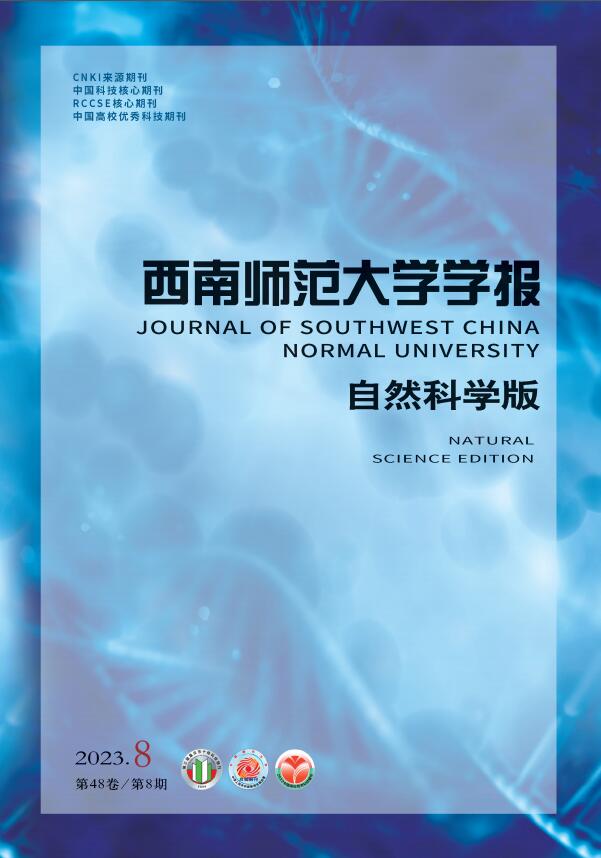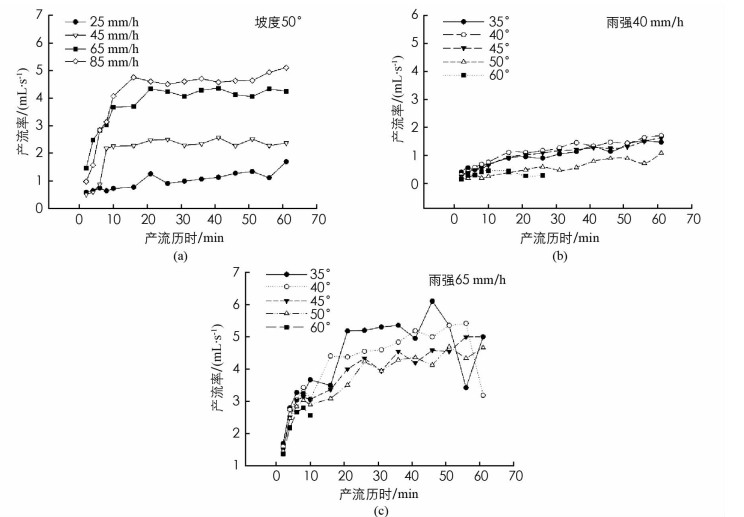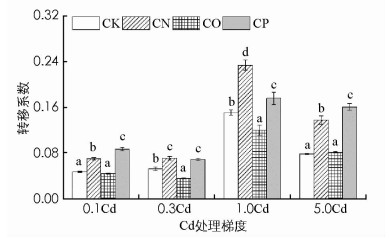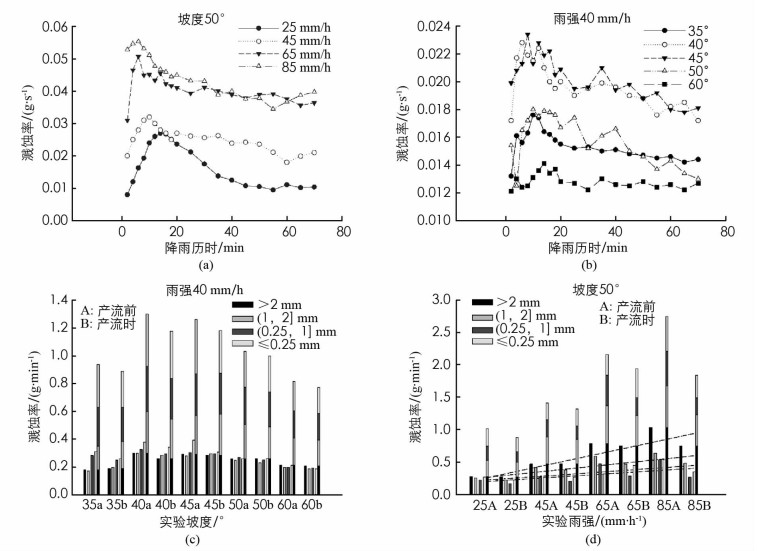-
随着我国城市化和工业化进程的加剧,土壤重金属污染日益严重[1].镉污染在无机污染物中超标率最高[2],易被作物吸收并通过食物链在人体内富集,对人体健康产生极大威胁[3].目前,土壤镉的植物修复研究广受重视,但研究对象多为种类少、生长期短的超富集植物[4],推广应用受到限制.木本园林植物生物量大、寿命长,对重金属表现出提取量大、固定时间长、固定效果稳定等特点[5-6],因而在土壤镉修复中极具应用价值.
香樟(Cinnamomum camphora)、肾蕨(Nephrolepis auriculata)和麦冬(Ophiopogon japonicus)均为西南地区常见的园林绿化植物,头花蓼(Polygonum capitatum)是西南地区常见的乡土植物.鲁艳等[7-10]发现木本植物香樟以及地被植物肾蕨、麦冬和头花蓼等均具有一定的镉(Cd)耐受、富集和转运能力.草本地被着生地表,根系分布于土壤浅层,与根系分布较深的木本植物配植,有可能促进木本植物生长和整体增强对土壤重金属的富集作用,而这方面的研究目前还鲜有报道.本试验将香樟与肾蕨等3种草本植物组合,采用溶液培养法研究不同组合对香樟生长和富集Cd的影响.
HTML
-
香樟、肾蕨、麦冬和头花蓼采集自西南大学校内,用半量的改良Hoagland营养液培养.
-
香樟种子于2017年12月采集,催芽;2018年3月初播种;5月初挖取高10 cm左右的幼苗进行试验.肾蕨、麦冬和头花蓼原株采于2018年3月初和4月,均在温室内分株、扦插繁育.
-
在营养液中添加CdCl2·2.5H2O(分析纯)对幼苗进行Cd胁迫处理,设4个质量浓度梯度:0.1 mg/L(0.1 Cd),0.3 mg/L(0.3 Cd),1.0 mg/L(1.0 Cd)和5.0 mg/L(5.0 Cd).
-
设3种木—草植物组合:香樟—肾蕨(CN)、香樟—麦冬(CO)、香樟—头花蓼(CP),对照(CK)为香樟.每组合处理4株(木、草各2株,对照木共4株),重复5次.
水培容器为方口塑料瓶,长9 cm、宽7.5 cm、高10 cm,容量为600 mL,用报纸和黑色不透光地膜包装瓶身,保障水培容器瓶身不透光.胁迫处理前幼苗先在去离子水中培养3 d,然后在营养液中预培养3周,待长出白色新根后开始进行Cd胁迫处理.胁迫期间,不换培养液,每天2次人工翻根换气40 min,每天用去离子水补充液面,保持液面高度5.8 cm,体积350 mL,并对幼苗同时进行光照培养.光源为红蓝光LED灯,光照强度为5000 lx(12 h/d),昼夜温度为25/18℃,胁迫处理4周后进行生物量和Cd质量浓度测定.
-
将香樟幼苗地上部分与根部分离,根部在20 mmol/L EDTA-Na2中螯合20 min,去除表面Cd2+,用去离子水冲洗3遍.将各部分于烘箱105 ℃杀青30 min,然后80 ℃烘至恒质量,用万分之一电子天平测质量.
-
将干燥香樟幼苗用植物微样粉碎机粉碎,过1 mm尼龙筛,经HNO3-HClO4混合消化后定容[11],用日立Z-5000原子吸收分光光度计测地上部和根的Cd质量比.
-
用日立Z-5000原子吸收分光光度计测定试验起始和结束时水溶液的Cd质量浓度.
-
试验数据利用Microsoft Excel 2016统计平均数,用SPSS 25.0软件对不同处理间的差异进行Duncan's多重比较,用Origin 2018作图.
转移系数(translocation factor,TF)的计算公式为[12]:
Cd富集量(M,μg/株)的计算式为:
式中:C为香樟对应部位的Cd质量比(μg/g);m为香樟对应部位的生物量(g).
重金属Cd去除率(修复率)的计算公式为:
1.1. 试验材料
1.2. 试验方法
1.2.1. 试验材料
1.2.2. Cd胁迫水平
1.2.3. 木—草组合及试验处理
1.3. 测定指标及方法
1.3.1. 香樟生物量(干质量)
1.3.2. 香樟Cd质量比的测定
1.3.3. 水溶液Cd质量浓度的测定
1.4. 数据处理与分析
-
香樟幼苗不同部位的生物量因组合模式和Cd质量浓度不同而存在较大差异(表 1). CN和CO组合在所有质量浓度下香樟地上、根部和全株的生物量均显著大于CK(p < 0.05).当Cd质量浓度为5.0 mg/L时,CN和CO组合全株生物量分别为0.273 g/株和0.265 g/株,比CK提高了46.77%和42.47%(p < 0.05).结果表明,香樟与肾蕨或麦冬配植显著促进了香樟生物量的积累.
-
不同组合模式下香樟不同部位的Cd质量比有差异,同一组合模式香樟各部位Cd质量比随Cd质量浓度的升高而升高,Cd质量浓度为5.0 mg/L时达到最大值(图 1). CN组合香樟地上部Cd质量比在各质量浓度下均显著高于CK(p < 0.05),表明与肾蕨组合培养可提高香樟地上部Cd质量比. CO组合恰好相反(p < 0.05),提示与麦冬配植将减少香樟地上部Cd积累.当Cd质量浓度为5.0 mg/L时,CK根部Cd质量比高于所有组合,分别比CN组合、CO组合和CP组合提高了35.83%,21.09%,和86.07%(p < 0.05),提示高质量浓度Cd环境下,草本植物根部也大量吸收Cd,降低了溶液中的Cd质量比,对香樟起了一定的协同保护作用.
-
由表 2可知,CN组合在所有质量浓度下香樟地上部和全株Cd富集量均极显著大于CK(p<0.01).当Cd质量浓度为0.1 mg/L时,地上部和全株的Cd富集量分别比CK提高了137.88%和77.86%(p<0.01).其余质量浓度地上部和全株的Cd质量比也显著高于其他组合,说明CN组合能有效促进香樟对Cd的吸收和转运,而其他组合的促进作用不明显.
-
各Cd质量浓度下,所有组合香樟的Cd转移系数均小于1,说明香樟不属于Cd超富集植物(图 2),但CN组合和CP组合各质量浓度下香樟Cd转移系数均显著大于CK(p < 0.05). Cd质量浓度1.0 mg/L时,CN组合香樟Cd转移系数最大,达0.234;Cd质量浓度为5.0 mg/L时,CN和CP组合香樟Cd转移系数分别为0.161和0.138,比CK分别提高76.92%和106.41%(p < 0.05),提示香樟与肾蕨和头花蓼配植能够促进Cd向香樟地上部转移.
-
不同Cd质量浓度下,不同木—草组合对培养液的Cd去除率不同.胁迫浓度越高,Cd去除率越低(图 3).但在所有胁迫质量浓度下,CO组合的Cd去除率均显著高于其他组合.当Cd质量浓度为0.1 mg/L时,Cd去除率达68.67%,比CK提高50.01%.研究结果表明,CO组合能够比其余组合更有效地去除环境中的Cd.
2.1. 地被植物对香樟幼苗生物量的影响
2.2. 地被植物对香樟幼苗Cd质量比的影响
2.3. 地被植物对香樟幼苗Cd富集量的影响
2.4. 地被植物对香樟幼苗Cd转移系数的影响
2.5. 不同木—草组合对培养溶液Cd去除率的影响
-
试验结果表明,香樟与肾蕨、麦冬和头花蓼配植对其生长和富集Cd有促进作用.其中,香樟与肾蕨配植积极影响最全面,与麦冬配植Cd去除率最高.
3种草本地被植物对香樟生物量有不同程度的影响,麦冬和肾蕨促进生长的作用较明显,可能是根系分泌物对香樟的生长产生了积极影响;也可能是麦冬和肾蕨也同样大量吸收了环境中的Cd,缓解了Cd对香樟的抑制和毒害,有利于香樟的生长.
研究结果表明,草本植物(肾蕨)与香樟配植促进了香樟对Cd的吸收和转运,此类现象在其他作物中也曾被发现.蒋成爱等[13]研究发现,东南景天与玉米和大豆的混作显著提高了其地上部分对Zn的吸收,显著降低了玉米和黑麦草对Cd和Zn的吸收;赵颖等[14]指出,不同间作作物对玉米吸收重金属的效果不同.原因可能是因为植物根系的分泌物能影响重金属的活性或存在状态,从而影响植物对重金属的吸收[15].由于植物种类不同,根系分泌物的种类和含量存在差异[16],所以不同植物组合栽培时,根系环境会随之改变[17],可能进而改变了香樟对重金属的吸收和转运.有研究认为,Cd在液泡中的区室化是阻止Cd长距离运输的有效途径[18],有可能肾蕨和头花蓼减弱了香樟根部对Cd的区室化作用,促进Cd向地上部运输.本试验表明,肾蕨和头花蓼能显著促进Cd向香樟地上部的转运,可以有效提高香樟对Cd的提取效率,此研究结果具有很大的应用价值.
本试验结果还表明,麦冬与香樟配植提高了水溶液Cd的去除率,且此组合Cd去除率均高于其余组合.麦冬对香樟吸收Cd的促进作用不明显,可能是麦冬本身的Cd吸收富集能力很强,吸收了水溶液中大量的Cd,使得CO组合的Cd去除率最高.实际应用中可利用麦冬Cd吸收量大的优势,采用定期收获再播种的方式,加快修复进程.









 DownLoad:
DownLoad: